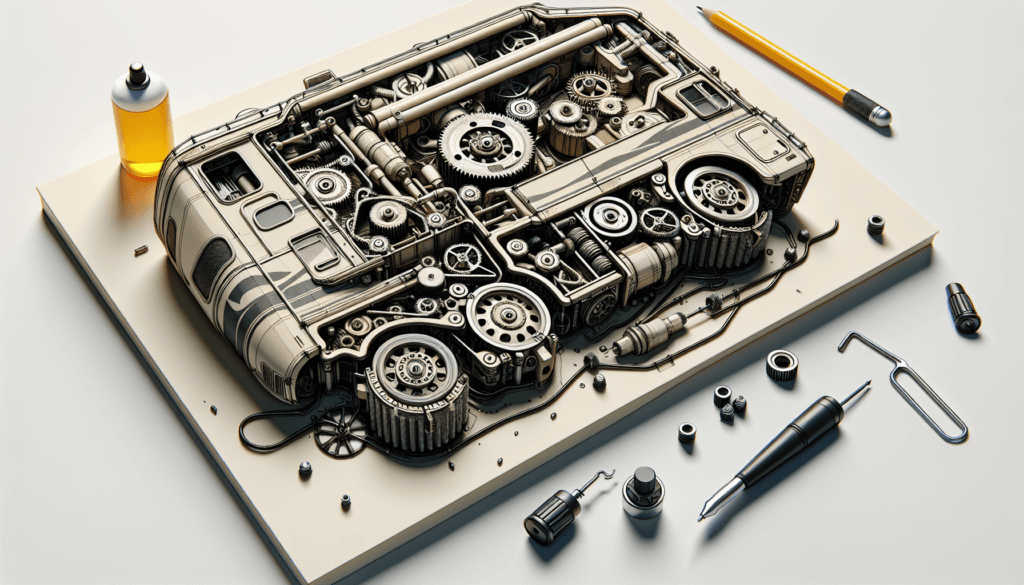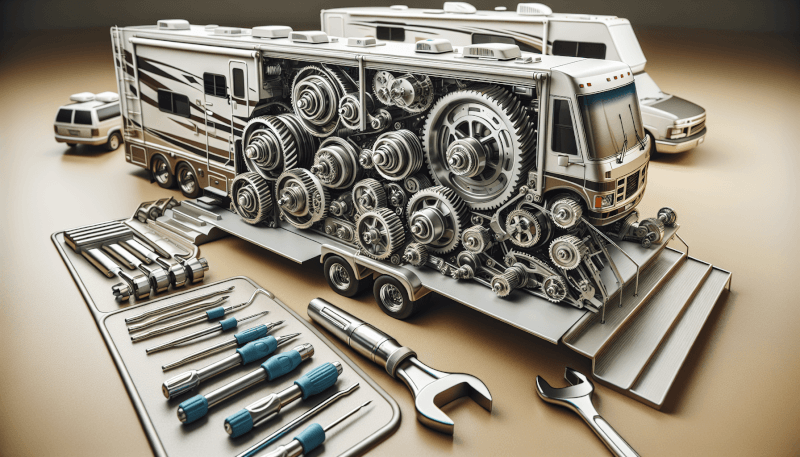Maintaining your RV slide is essential for a smooth and enjoyable road trip. From preventing leaks to ensuring proper functionality, taking care of your RV slide will save you headaches in the long run. In this article, we will explore the importance of RV slide maintenance and provide you with simple yet effective tips to keep your slide in peak condition. So, let’s get started and make sure your next adventure is trouble-free!
RV Slide Types
There are different types of RV slides that are commonly found in recreational vehicles. These slides are designed to expand the living space of the RV when parked, allowing for more room and comfort. The three main types of RV slides are:
Electric Slide
Electric slides are operated by an electric motor that extends and retracts the slide at the push of a button. They are easy to use and require minimal physical effort. Electric slides are popular due to their convenience and smooth operation.
Hydraulic Slide
Hydraulic slides use hydraulic systems to power the extension and retraction of the slide. These slides are known for their strength and durability. Hydraulic systems provide a high level of power and stability, making them ideal for larger and heavier RVs.
Manual Slide
Manual slides require manual operation to extend and retract the slide. This type of slide is typically operated using a hand crank or lever. Manual slides are the most basic type and are often found in smaller RVs or older models. While they may require more effort to operate, they are generally reliable and straightforward.
Common Slide Problems
RV slides can experience various issues that may affect their operation. Here are some common problems RV owners may encounter:
Slide Not Extending or Retracting Fully
One of the most common issues is when the slide does not extend or retract fully. This can be caused by a malfunctioning motor, a faulty switch, or an obstruction in the slide mechanism. It is important to address this issue promptly to prevent further damage.
Slide Moving Unevenly
If you notice that the slide is moving unevenly, it could indicate an alignment problem or an issue with the slide mechanism. Uneven movement may put stress on the slide and potentially cause damage if not addressed.
Slide Sticking or Binding
A slide that sticks or binds when extending or retracting can be a frustrating problem. This can occur due to debris or dirt in the slide mechanism, worn-out components, or misalignment. Regular cleaning and maintenance can help prevent this issue.
Slide Leaking
Leaking slides can be a result of damaged seals or faulty slide mechanisms. Water intrusion can cause significant damage to the RV’s interior if not addressed promptly. Regular inspections and proper seal maintenance can help prevent leaks.

Regular Inspections
Regular inspections are essential to ensure the proper functioning of RV slides. It is recommended to perform these inspections at least twice a year or more frequently if you use your RV frequently. Here are the key areas to inspect:
Inspecting Slide Seals
Check the condition of the slide seals to ensure they are intact and not damaged. Look for any signs of cracking, tearing, or deterioration. Damaged seals should be repaired or replaced to maintain a watertight seal.
Checking Slide Mechanism
Inspect the slide mechanism for any signs of wear or damage. Look for loose or missing bolts, bent parts, or excessive rust. Ensure that all moving parts are lubricated properly. Any issues should be addressed promptly to prevent further damage.
Examining Slide Floor
Check the slide floor for any signs of water damage, soft spots, or delamination. Water intrusion can cause significant structural damage if not addressed promptly. Repair or replace any damaged areas as necessary.
Cleaning and Lubricating the Slide
Regular cleaning and lubrication are vital to maintain the smooth operation of RV slides. Here are the recommended steps for cleaning and lubricating the slide:
Cleaning Slide Seals
Clean the slide seals using mild soap and water. Remove any dirt or debris that may have accumulated. Ensure that the seals are thoroughly dry before applying a silicone-based slide seal conditioner to keep them supple and prevent cracking.
Lubricating Slide Mechanism
Apply a lubricant specifically designed for RV slide mechanisms to all moving parts. This will help prevent friction and ensure smooth operation. Be sure to follow the manufacturer’s recommendations for the type and amount of lubricant to use.
Inspecting and Cleaning Slide Tracks
Inspect the slide tracks for any dirt, debris, or obstructions. Use a soft brush or cloth to clean the tracks and remove any buildup. Keeping the tracks clean will help prevent sticking or binding.

Adjusting Slide Alignment
Proper slide alignment is crucial for smooth operation and to prevent damage. If you notice any misalignment, follow these steps to adjust the slide:
Identifying Misalignment
Observe the slide as it extends and retracts to determine if it is misaligned. Look for any uneven movement or gaps between the slide and the RV sidewalls. This can indicate a need for adjustment.
Adjusting Slide Mechanism
Refer to the RV manufacturer’s instructions or consult a professional for guidance on adjusting the slide mechanism. This may involve loosening or tightening bolts, adjusting slide arms or rollers, or realigning the slide mechanism.
Verifying Proper Alignment
After making adjustments, verify the slide’s alignment by extending and retracting it several times. The slide should move smoothly without any binding or uneven movement. Make additional adjustments if necessary to achieve proper alignment.
Seal Maintenance and Replacement
Proper maintenance of slide seals is essential to prevent water intrusion and maintain the integrity of the RV. Here are the recommended steps for seal maintenance and replacement:
Inspecting and Cleaning Slide Seals
Regularly inspect the slide seals for any signs of wear, damage, or deterioration. Clean the seals with mild soap and water to remove dirt or debris. Allow them to dry before applying a silicone-based slide seal conditioner.
Repairing or Replacing Damaged Seals
If you notice any significant damage to the slide seals, such as cracks or tears, they should be repaired or replaced promptly. Damaged seals will compromise the slide’s ability to provide a watertight seal and may require professional assistance to replace.
Hydraulic Slide Maintenance
RVs with hydraulic slides require specific maintenance to ensure their proper functioning. Here are the key maintenance tasks for hydraulic slides:
Checking Hydraulic Fluid Level
Regularly check the hydraulic fluid level and top it up as necessary. Follow the manufacturer’s recommendations for the type of hydraulic fluid to use and the proper procedure for checking and adding fluid.
Inspecting Hydraulic Hoses and Fittings
Inspect the hydraulic hoses and fittings for any signs of wear, leaks, or damage. Tighten any loose fittings and replace any damaged hoses promptly. Regular inspections will help prevent hydraulic system failure.
Maintaining Hydraulic Pump and Motor
Ensure that the hydraulic pump and motor are clean and free from dirt, debris, or obstructions. Regularly inspect them for any signs of wear or damage. Lubricate any moving parts according to the manufacturer’s recommendations.
Electric Slide Maintenance
Proper maintenance of electric slides will help prolong their lifespan and ensure reliable operation. Follow these maintenance steps for electric slides:
Checking Wiring Connections
Regularly check the wiring connections for any signs of loose or corroded connections. Ensure that all electrical connections are tight and secure. Any damaged wires or connectors should be repaired or replaced promptly.
Testing Slide Motor
Test the slide motor periodically to ensure it operates smoothly and without any issues. Listen for any unusual noises or vibrations during operation. Any problems with the slide motor should be addressed promptly.
Inspecting and Lubricating Gear System
Inspect the gear system for any signs of wear, damage, or debris buildup. Clean the gears with a soft brush or cloth and lubricate them with a suitable lubricant to ensure smooth operation. Refer to the manufacturer’s recommendations for the type and amount of lubricant to use.
Manual Slide Maintenance
While manual slides require more physical effort to operate, they still require regular maintenance to function optimally. Here are the steps for maintaining manual slides:
Cleaning and Lubricating Manual Slide Mechanism
Clean the manual slide mechanism using a mild soap and water solution. Remove any dirt or debris that may have accumulated. Lubricate the moving parts with a suitable lubricant to prevent friction and ensure smooth operation.
Inspecting Slide Gears and Tracks
Inspect the slide gears and tracks for any signs of wear, damage, or obstruction. Use a soft brush or cloth to clean the gears and tracks and remove any buildup. Regular cleaning and inspection will help prevent sticking or binding.
Testing and Adjusting Manual Slide Crank
Periodically test the manual slide crank to ensure it operates smoothly and without any issues. If you notice any difficulty or resistance in operating the crank, it may require adjustment. Consult the RV manufacturer’s instructions for guidance on adjusting the manual slide crank.
Weatherproofing the Slide
Protecting the RV slide from the elements is important to prevent water intrusion and damage. Here are the steps to weatherproof the slide:
Applying Slide Seal Conditioner
Regularly apply a silicone-based slide seal conditioner to the slide seals. This will help keep the seals supple, prevent cracking, and maintain a watertight seal. Follow the manufacturer’s instructions for the proper application of the conditioner.
Protecting Slide from Elements
When not in use, consider using a slide cover to protect the slide from the elements. This will help prevent dirt, debris, and water from accumulating on the slide and potentially causing damage. Additionally, ensure that the RV is level to prevent water pooling on the slide roof.
By following these maintenance tips and regularly inspecting and caring for your RV slide, you can ensure its smooth operation and prolong its lifespan. Remember to always refer to the RV manufacturer’s instructions and seek professional assistance if needed. Happy RVing!


